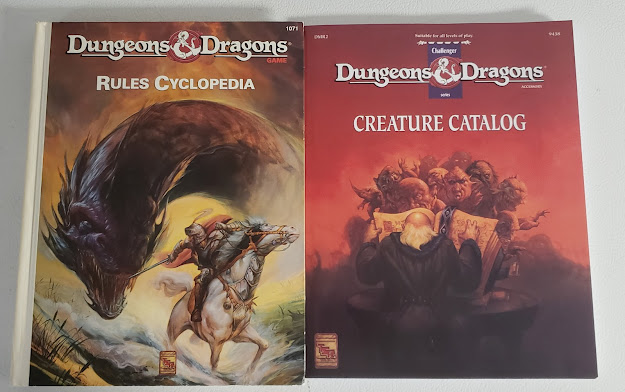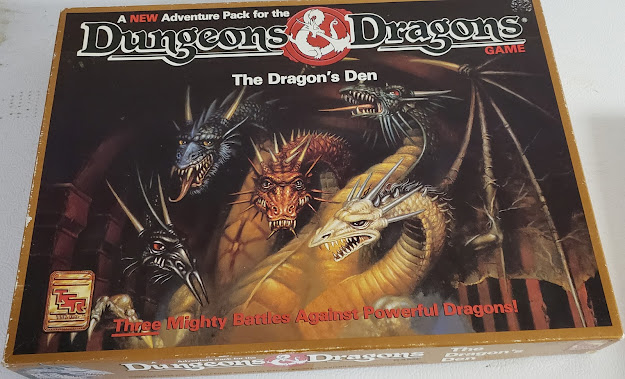So far we have run into six named Immortals; Koryis, Kersy (more on her later!), Vanya and Alphaks from Into the Maelstrom and Orcus and Demogorgon from the Immortals DM's Book. None are mentioned (too my knowledge) in the module The Immortal Storm. Of these five, three are demons. Not just demons in the general sense, but demons in the AD&D (and now D&D) sense.
One thing made clear in the Immortals game was that Immortals are not gods. They are powerful beings, with near unlimited magical powers, who occupy the outer planes, and are worshipped by clerics...what was my point here? Oh not gods. Right, totally not gods. Nope.
Except they are.
Alphaks aside (he is a special case), Orcus and Demogorgon are immortals, and demons, and (let's be honest here) minor gods. Essentially what OMG is all about.
In the D&D Rules Cyclopedia Immortals are discussed, but specific Immortals are rarely mentioned. Ka, Odin, and Atzanteotl are mentioned by name and have appeared in other BECMI products over the years. The conversion notes for D&D to AD&D 2nd Ed in the Cyclopedia gives us this little tidbit:
The Immortals of the D&D system and the deities of the AD&D system should not be converted between the game systems.
They were real set on the whole Immortals ≠ Gods thing.
I wanted to review The Wrath of the Immortals. But I don't have a copy and DriveThruRPG also doesn't have it. I have managed to piece together some of the immortals from other products and from the Vaults of Pandius. A couple of them stick out, Immortals and Faith and the Codex Immortalis by Marco Dalmonte.
A few of the "demonic" Immortals mentioned in other products are, Bagni Gullymaw, a demonic troll and the immortal of canibalism and Stodos, a cold-blood Type II/Hezrou demon. Bagni could be another name of the Other Side favorite Vaprak the destroyer.
What BECMI lacks, and really should have been a major contributor to, are new demons.
So instead of looking to the Gods and Immortals of this "mythos" like I normally do, I should look at the monsters and see which ones make for good demons.
Demons of BECMI
I should start this part off with a note about another post on Demons in BECMI from Mystara Sage in Residence, Bruce Heard. He posted about demons earlier this year and it is worth taking a look at.
Moving away from the Immortal-level rules I look back at the various monsters. To make my life easier I am just going to look at the D&D Rules Cyclopedia and D&D Creature Catalog.
The Plane of Nightmares was introduced to us in the X series of modules and would then later be expanded on in later Companion and Master books. There are a few creatures from this plane that certainly qualify as demons.
The devilish Diabolus appeared in the Immortals Set. They are described as looking like devils essentially but were in most ways human. They could take any human class and were their dimension's equivalent of humans. The BECMI rules even state they can be played as humans. They were updated in Dragon Magazine #327 as a character race.
Essentially these are Tieflings. You can play Chaotic or what 5e called demonic tieflings. I'd argue they can only choose "Chaotic" alignment, so Chaotic Good (their default in 2e), Chaotic Neutral or Chaotic Evil.
Malfera
Few creatures fit the description and general attitude of a demon better than the Malfera. Let's get into some details. In the Rules Cyclopedia, we learn they are chaotic. can only be summoned to our plane by a powerful magic-user or Immortal. They are a planar monster. They have massive physical attacks and special attacks. Can open doors as per knock and has higher than normal saves. Plus they are described as a literal nightmare creature. If not a demon, then "demon-adjacent."
There are stats for them all over the web. Here are some from the Vaults of Pandius for 2nd Ed AD&D, 3rd Ed D&D, 4th Ed D&D, and 5th Ed. D&D. A 3.5 version for the Forgotten Realms based on the Dragon #343 version. The Piazza also has a Malfera and there is another 5th edition version.
Here is the version from the Piazza linked above. They make it a large monstrosity, but they don't give it the extra-planar tag.
And there may be a Malfera / Maelephant connection. I am going to say related creatures from the same plane. Given that maybe there is a larger creature, a Masdaemon. sure, Why not.
Actually, it is close to an idea I was playing with back when I was writing Ghosts of Albion.
Hellephant
FREQUENCY: Very Rare
NO. APPEARING: 1-2 (4-9)
ARMOR CLASS: 0
MOVE: 18"/36", special stampede 24"/48"
HIT DICE: 12+36 (90 hp)
% IN LAIR: 95%
TREASURE TYPE: Nil, Special
NO. OF ATTACKS: 2 + 2 special
DAMAGE/ATTACK: 2-24 (2d12) trample, 2-12 (2d6) gore, 4-48 (4d12) swallow
SPECIAL ATTACKS: Breath Weapon, Swallow whole
SPECIAL DEFENSES: +2 or better weapon to hit
MAGIC RESISTANCE: 10%
INTELLIGENCE: Animal (savage)
ALIGNMENT: Chaotic Evil
SIZE: L (20' tall)
PSIONIC ABILITY: Nil, immune to Psionic attacks
Deep in the pits of the abyss roams the monstrous Hellephant. Believed to be related to both the Malfera and the Maelephant, these creatures are roaming, ever-hungry nightmares.
They appear to be Mastodons, only twice as large. Their fur appears to be black, but in truth soaked in blood. Their tusks come out from their bottom jaw and curve downward. This allows them too run their prey down and scoop them up into their terrible maw. The hellephant is a voracious carnivore and their preferred prey is anything warmblood that will run from them. Their attacks are a trample or a gore. On a successful gore hit the victim must make a saving throw vs. Paralyze or be scooped into the hellwphant's maw. Once there they are bitten by the monster's rough teeth, still in the shape of the teeth of a plant-eater, and then they are swallowed whole. The digestive acid causes 4d12 points of damage per round. Resistance to acid attacks can reduce this to half. The hellephant's digestive system though is not adapted to eating meat so living creatures are exited out in the way of all digested food in 1d4 rounds. The expelled victim, if still alive need to make another save vs. paralysis in order to get up and move out of the way. The Hellephant, still ravenous, returns to scoop up any victims that are too slow to move and the eating and digestion process begins again.
If a group of 6 or more Hellephants are present they may stampede. They will run in one direction for several minutes causing maximum trample damage. They will not return to eat any victims left behind.
Hellephants have no treasure, but their ivory is prized through-out the multiverse and is, pound for pound, 10x the price terrestrial elephant ivory.
Tabi
These small, winged-ape like creatures are chaotic. They are somewhere between an imp and a flying monkey.
There are a lot of Chaotic Evil monsters in Post-BECMI Mystara that have appeared that would make good demons. I think these are the most likely candidates.
I also think, given the mythos of the world and the roots of it, that demons are fine, but devils (as defined by AD&D 1st Edition) are not. But hey, that is only for my games.









































